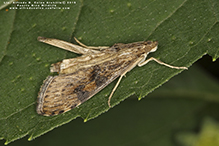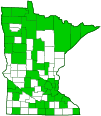lucerne moth
(Nomophila nearctica)
Conservation • Description • Habitat • Ecology • Distribution • Taxonomy
|
||||||||
| Hodges # | 5156 |
|||||||
Conservation Status |
||||||||
| IUCN Red List | not listed |
|||||||
| NatureServe | NNR - Unranked SNR - Unranked |
|||||||
| Minnesota | not listed |
|||||||
Description |
||
Lucerne moth is a medium-sized moth, a large crambid moth. It occurs throughout the United States, across southern Canada, and in Mexico. It is common in Minnesota. Adults are found from April to November on low herbaceous plants in fields, lawns, roadsides, and weedy waste places. Larvae feed on the foliage of a large variety of low-growing plants, including alfalfa, clover, sweet clover, smartweed, and grasses. Adults are narrow and long, ⅝″ (15 mm) in length. They have a wingspan of 15⁄16″ to 1⅜″ (24 to 35 mm). The forewings are narrow, rounded at the tip, and brown, with darker, blackish-brown spots and streaks, and grayish-brown veins. There is a circular spot (orbicular spot) in the upper median area, a circular spot (claviform spot) between the orbicular spot and the inner margin, and a kidney-shaped spot (reniform spot) at the end of the discal cell. These spots have dark outlines and paler or slightly paler centers. The orbicular and claviform spots are large and closely spaced, sometimes converging into a single two-lobed spot. The median area sometimes has a small or large orangish patch, at least between the upper and lower spots. There is a dark line below the median area (postmedial of PM line). The PM line curves upward beyond the middle then angles sharply downward approaching the inner margin. There are four dark spots at the leading edge (costal margin) on the lower half of the wing, and a dark patch in the subterminal area near the costal margin. The outer margin has singular, narrowly triangular, forward-pointing spots between the veins. The fringe is banded white and dark brown. The hindwing is broader than the forewing. It is pale tan with gray streaks and dark brown veins but is otherwise unmarked. The fringe on the hindwing is white. The antennae are slender and thread-like. The finger-like sensory organs (palps) attached to the mouth are long and densely hairy. They are projected forward, appearing like a fuzzy snout. The caterpillar may be pale and reddish-brown or brownish-gray, or it may be dark and gray. The head is black. The thoracic shield is pale with two large black bumps that cover more than half of the upper surface. The legs on the thorax are pale. There is a narrow dark stripe in the middle (middorsal) of the thorax and abdomen bordered with white. On each abdominal segment there are two pairs of large black bumps on the upper side and a single similar but smaller bump in each side. Each bump has a few long erect hairs (setae). |
||
Size |
||
Total length: ⅝″ (15 mm) Wingspan: 15⁄16″ to 1⅜″ (24 to 35 mm) |
||
Similar Species |
||
Habitat |
||
Fields, lawns, roadsides, and weedy waste places |
||
Ecology |
||
Season |
||
April to November |
||
Behavior |
||
Adults hold their wings folded flat and overlapped when at rest. They are active at night and will come to lights. |
||
Life Cycle |
||
|
||
Larva Hosts |
||
Foliage of a large variety of low-growing plants, including alfalfa, clover, sweet clover, smartweed, and grasses. |
||
Adult Food |
||
|
||
Distribution |
||||
|
Sources |
|||
| 12/21/2020 | ||||
Occurrence |
||||
Common in Minnesota |
||||
Taxonomy |
|||
Order |
Lepidoptera (Butterflies and Moths) | ||
Superfamily |
Pyraloidea (Pyralid and Crambid Snout Moths) | ||
Family |
Crambidae (Crambid Snout Moths) | ||
Subfamily |
Spilomelinae (pearl moths) | ||
Genus |
Nomophila | ||
In 2009 the spelling of the genus name was changed from Nomophilia to Nomophila. |
|||
Synonyms |
|||
Nomophilia nearctica
Eristalis fascicollis ristalis fascicollis ristalis philadelphicus Eristalis pumilus Eristalis vittata Eristalis zonatus Eristalomyia calomera Nomophilia nearctica |
|||
Common Names |
|||
clover nomophila lucerne moth (adult) American Celery Webworm (caterpillar) Celery Stalkworm (caterpillar) False Webworm (caterpillar) |
|||
Glossary
Claviform spot
A club-shaped, wedge-shaped, or round spot in the upper median area, between the orbicular spot and the inner margin, connected to the AM line, on the forewing of many moths.
Orbicular spot
A circular spot or outline in the upper median area near the antemedial line on the forewing of many moths.
Palp
Short for pedipalp. A segmented, finger-like process of an arthropod; one is attached to each maxilla and two are attached to the labium. They function as sense organs in spiders and insects, and as weapons in scorpions. Plural: palpi or palps.
Postmedial (PM) line
A thin line separating the median area and the postmedial area of the forewing of Lepidoptera.
Reniform spot
A kidney-shaped spot or outline in the lower median area near the PM line on the forewing of many moths.
Seta
A stiff, hair-like process on the outer surface of an organism. In Lepidoptera: A usually rigid bristle- or hair-like outgrowth used to sense touch. In mosses: The stalk supporting a spore-bearing capsule and supplying it with nutrients. Plural: setae. Adjective: setose.
Visitor Photos |
|||||
Share your photo of this insect. |
|||||
| This button not working for you? Simply email us at info@MinnesotaSeasons.com. Attach one or more photos and, if you like, a caption. |
|||||
Alfredo Colon |
|||||
 |
|||||
MinnesotaSeasons.com Photos |
|||||
|
|||||

Visitor Videos |
|||
Share your video of this insect. |
|||
| This button not working for you? Simply email us at info@MinnesotaSeasons.com. Attach a video, a YouTube link, or a cloud storage link. |
|||
Other Videos |
|||
Crambid Moth (Crambidae: Nomophila nearctica) on Blossom |
|||
About
Sep 5, 2010 Photographed at Kellys Slough NWR, North Dakota (05 September 2010). Go here to learn more about this species: http://bugguide.net/node/view/9485 |
|||
Lucerne Moth (Crambidae: Nomophila nearctica) Dorsal View |
|||
About
Oct 13, 2011 Photographed at the Turtle River State Park, North Dakota (09 October 2011). Thank you to Paul Dennehy (@Bugguide.net) for confirming the identity of this specimen! |
|||

Created: 12/21/2020
Last Updated:




